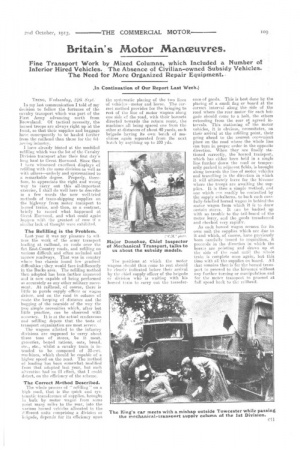Britain's Motor Manceu.vres.
Page 15

If you've noticed an error in this article please click here to report it so we can fix it.
TRING, Wednesday, -.4th Sept: In my last communication I told of my decision to follow the fortunes of the cavalry transport which was part of the First Army advancing north from Brownland. Of tactical necessity, the horsed troops are always right up at the front, so that their supplies and baggage have consequently to be hauled further from the railhead than these for the lotiowi ltg infantry.
1 have already hinted at the muddled refilling which was the lot of the Cavalry Division transport, after their first. day's long haul to Great. Horwood. Since then I have witnessed excellent displays of refilling with the same division as well as with others—orderly and systematized to a remarkable degree. Properly, therefore, to appreciate the right and wrong way to carry out, this all-important exercise, I shall do well here to describe in a few words the now well-tried methods of trans-shipping supplies on the highway from motor transport to horsed trains, and then, as a contrast., briefly to record what happened at Groat Horwood, and what, could again happen with the greatest of ease if a similar lack of thought were exhibited.
The Refilling is the Problem.
Last year it was my pleasure to witness the work of the army transport loading at railhead, en route over the flat East-Country roads, and refilling on various difficult and often secluded and narrow roadways. That was in country whefe bus chassis found few gradient. difficulties; they would fare indifferently in the Bucks area. The refilling method then adopted has been further improved and is now capable of being performed as accurately as any other military movement. At railhead, of course, there is little to puzzle supply officer or wagon driver, and on the road in column of route the keeping of distance and the hugging of the nearside of the way the two simple necessities which, after but little practice, can be observed with accuracy. It is at the actual rendezvous. and refilling depots that the tests of transport organization are most severe.
The wagons allotted to the infantry divisions are supposed to' carry about three tons of stores, be it meat, gioceries, boxed rations, oats, bread, etc., etc., whilst a cavalry train is intended to be composed of 30-cwt. machines, which should be capable of a higher speed on the road. The Method of loading has been somewhat Modified from that adopted last year, but such alteration had no ill effect, that I could detect, on the efficiency of the scheme.
The. Correct Mothod Described.
The whole process of " refilling " on a high road, that is the quick and systematic transference of supplies, brought in bulk by motor wagon from some Point many miles to the rear, into the various horsed vehicles allocated to the different units comprising a. division or lAigade, depends for its efficiency upon the systematic placing of the two lines of vehicles—motor and horse. The correct method provides for the bringing to rest of the line of motor, wagons along one side of the road, with their bonnets directed towards the return route, the machines all being spaced one from the other at. distances of about 40 yards, each brigade having its own batch of machines again separated from the next. hatch by anything up to 100 yds.
The positions at which the motor wagons should thus conic to rest should he clearly indicated before their arrival by the (Thief supply officer of the brigade or division who is waiting with his horsed train to carry out. the transfer
ence of goods. This is best done by the placing of a small flag -or hoard at the correct interval along theside of the read where the rear motor • f& each brigade should come to a halt, the others extending from the rear at agreed intervals. This stationing or the motor vehicles, it is obvious, necessitates, on their arrival at the refilling point, their going ahead to the nearest convenient place on the road where the whole line can turn in proper order in the opposite direction. When they are finally stationed correctly, the horsed transport, which has either been held in a single line further down the road or temporarily parked in adjacent fields, is brought along towards the line of motor vehicles and travelling in the direction in which it will ultimately leave for the bivouac. where the troops are awaiting the supplies. It is then a simple method, and one which can readily be controlled by the supply subalterns, to back each carefully-labelled horsed wagon in behind the motor wagon from which it is to draw certain stores. It can be hacked up with no trouble to the tail-board of the motor lorry, and the goods transferred . and checked very rapidly.
As each horsed wagon secures for its own unit the supplies which are due to it and which, of course, have previously been carefully issued to requisition, it proceeds in the direction in which the horses are pointing and draws up at the side of the read until the whole train is complete once again, but this time with all the supplies on board. All that remains then is for the horsed transport to proceed to the bivouacs without any further turning or manipulation and for the motor transport to proceed at full speed back to the railhead.


























